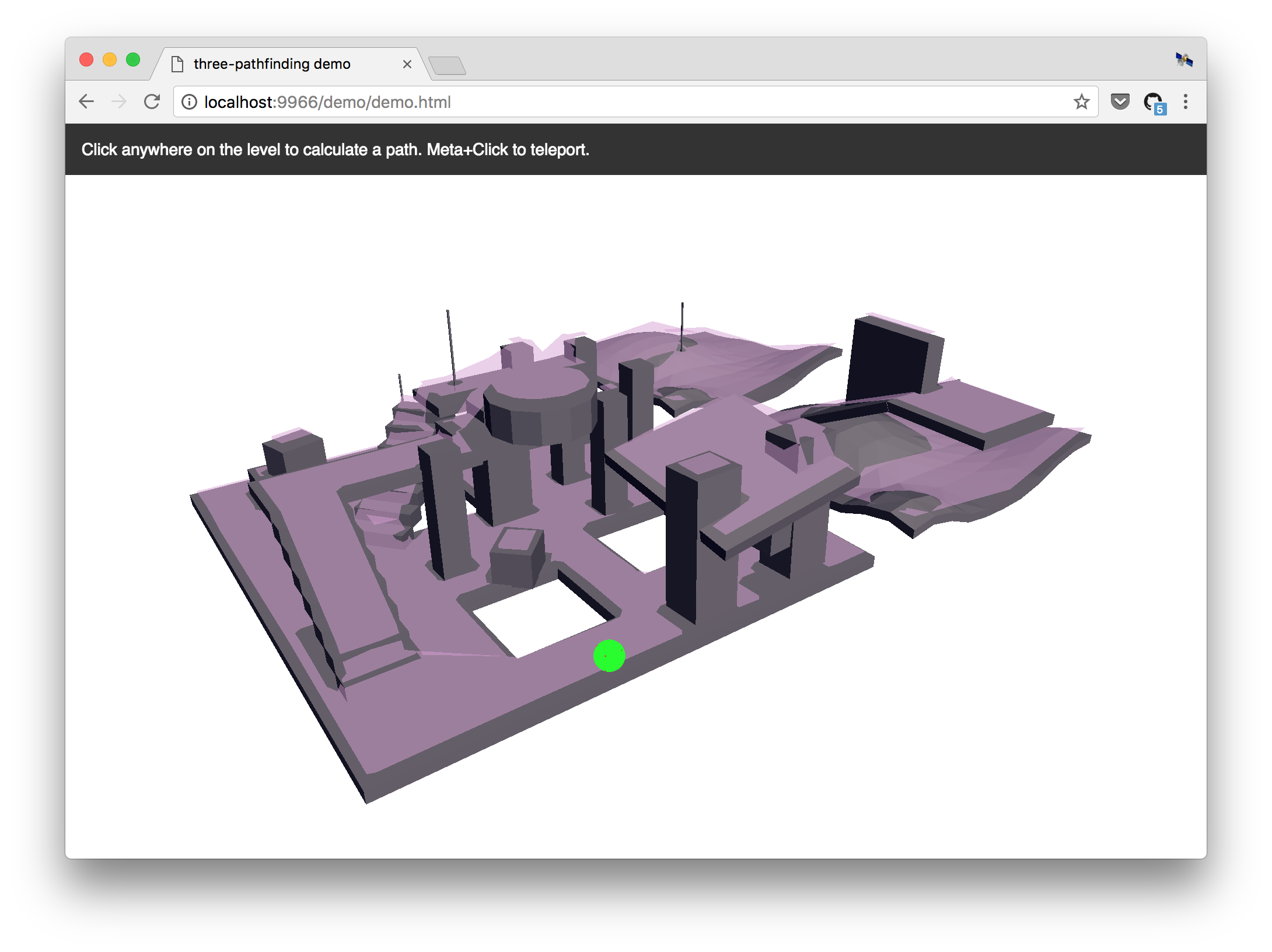three-pathfinding



Navigation mesh toolkit for ThreeJS, based on PatrolJS. Computes paths between points on a 3D nav mesh, supports multiple zones, and clamps movement vectors for FPS controls. To learn how to create a navigation mesh using Blender, see Creating a Nav Mesh.
Thanks to Nick Janssen for creating PatrolJS, which was the basis for this library.

Introduction
Traditionally games and 3D apps used waypoints to help their AI agents navigate. This is bad and has a lot of problems, but is generally easier to implement than navigation meshes. Navmeshes are far more accurate, faster, and take into account the size of the AI agent (e.g. tanks require move space to maneuver than soldiers).
For a thorough introduction to Navigation mesh pathfinding, see AI Blog's article, Fixing Pathfinding Once and For All.
Quickstart
Installation
npm install --save three-pathfinding
Creating a Navigation Mesh
This library does not build navigation meshes for you — instead, create a navigation mesh using Blender, Recast (CLI), or another tool.
The library accepts a THREE.Geometry instance, which can be loaded with any three.js loader and converted from BufferGeometry if necessary.
Example
Loading a mesh from a .gltf file:
let mesh;
const loader = new THREE.GLTFLoader();
loader.load( 'navmesh.gltf', ({scene}) => {
scene.traverse((node) => {
if (node.isMesh) mesh = node;
});
}, undefined, (e) => {
console.error(e);
});
Initializing the library, creating a level, and finding a path:
import { Pathfinding } from 'three-pathfinding';
const { Pathfinding } = require('three-pathfinding');
const Pathfinding = window.threePathfinding.Pathfinding;
const pathfinding = new Pathfinding();
const ZONE = 'level1';
pathfinding.setZoneData(ZONE, Pathfinding.createZone(mesh.geometry));
const groupID = pathfinding.getGroup(ZONE, a);
const path = pathfinding.findPath(a, b, ZONE, groupID);
Running the demo locally
git clone https://github.com/donmccurdy/three-pathfinding.git
cd three-pathfinding
npm install
npm run dev
The demo will start at http://localhost:9966/demo/.
API
Table of Contents
Pathfinding
Defines an instance of the pathfinding module, with one or more zones.
setZoneData
Sets data for the given zone.
Parameters
getRandomNode
Returns a random node within a given range of a given position.
Parameters
Returns Node
getClosestNode
Returns the closest node to the target position.
Parameters
position THREE.Vector3zoneID stringgroupID numbercheckPolygon boolean (optional, default false)
Returns Node
findPath
Returns a path between given start and end points. If a complete path
cannot be found, will return the nearest endpoint available.
Parameters
startPosition THREE.Vector3 Start position.targetPosition THREE.Vector3 Destination.zoneID string ID of current zone.groupID number Current group ID.
Returns Array<THREE.Vector3> Array of points defining the path.
getGroup
Returns closest node group ID for given position.
Parameters
zoneID stringposition THREE.Vector3
Returns number
clampStep
Clamps a step along the navmesh, given start and desired endpoint. May be
used to constrain first-person / WASD controls.
Parameters
start THREE.Vector3end THREE.Vector3 Desired endpoint.node NodezoneID stringgroupID numberendTarget THREE.Vector3 Updated endpoint.
Returns Node Updated node.
createZone
(Static) Builds a zone/node set from navigation mesh geometry.
Parameters
geometry THREE.BufferGeometry
Returns Zone
PathfindingHelper
Extends THREE.Object3D
Helper for debugging pathfinding behavior.
setPath
Parameters
Returns this
setPlayerPosition
Parameters
Returns this
setTargetPosition
Parameters
Returns this
setNodePosition
Parameters
Returns this
setStepPosition
Parameters
Returns this
reset
Hides all markers.
Returns this
Zone
Defines a zone of interconnected groups on a navigation mesh.
Properties
Group
Defines a group within a navigation mesh.
Node
Defines a node (or polygon) within a group.
Properties
Thanks to






